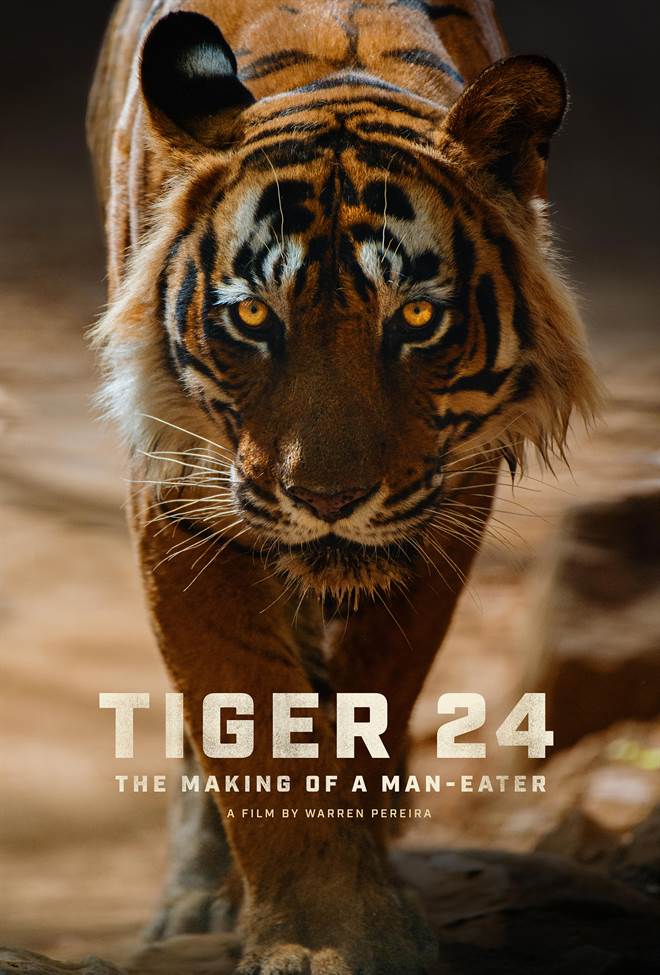Did you know the tiger is the largest living cat species on Earth and, with razor-sharp teeth and incredibly strong legs, they are feared by man and weaker animals alike? In the early Twentieth Century, these majestic creatures roamed freely throughout Asia and numbered in the tens of thousands. Today, thanks to poaching/hunting and the destruction of their natural habitat, there are approximately three thousand tigers remaining in the wild.
Setting out to make a film focusing on tiger conservation efforts in India's Ranthambhore National Park, filmmaker Warren Pereira found himself mesmerized by one particular tiger known as Ustad/Tiger 24. Over the next decade, Pereira would not only find himself studying Ustad and his family but he laid witness to how Ustad staked his claim on a large portion of the forest and his (semi) tolerance of the villagers who would pass through his territory on their way to the sacred Temple.
Pereira admits the film evolved over time until circumstances necessitated shifting his original concept from tiger conservation to a study of Ustad to where it finally ends up...a study into human nature and politics as the country becomes divided with half campaigning for Ustad's release from captivity and the other half arguing against it.
And what, might you wonder, caused Ustad's incarceration? Well, apparently tigers are territorial and don't like when predators enter their territory. Specifically, Ustad is charged with killing four humans over a period of five with the last one occurring on May 8, 2015, when Forest Guard Rampal Saini is killed.
Having had a history of attacking humans, Ustad was immediately perceived to be guilty. However, conservationists are quick to point out that there is no physical evidence linking Ustad to Rampal's death. Apparently, in the world of tiger conservation, the suspect is guilty until proven innocent. Less than two weeks later, Ustad finds himself in a cage, having been deemed too dangerous to live in the wild.
Pereira suddenly finds his documentary has shifted yet again and regardless of his personal feelings about Ustad's capture, he presents both sides of the argument, speaking with activists, villagers, and politicians in an effort to hear all sides of this polarizing argument.
Part of what is so wonderful about Pereira's film is that, as previously mentioned, he adapts and shifts when necessary, as events change the landscape of the conservation effort. His flexibility serves him well as his movie starts out as one thing, then becomes more focused until it takes a sharp right turn that I am sure very few saw coming.
Pereira has a keen eye for details and interesting angles, giving the viewer a true sense of just how physically large Ustad, his mate, Noor, and their two cubs are against the vast landscape of Ranthambhore. Pereira also tries to stay neutral in this war for freedom and does an excellent job of balancing the arguments for and against allowing the viewer to make up their own mind if Ustad should be returned to his home.
Thanks to Pereira's storytelling and his crew's ability to shoot excellent footage, the pacing of the film isn't slow or awkward and, unlike some other documentaries, it doesn't jump around from place to place or back and forth on a timeline that often comes across as disjointed and/or confusing. Pereira also infuses the film with moments designed to make the audience feel sympathetic towards Ustad which isn't the easiest thing to do since, let's face it, Ustad is a man-eating tiger after all.
Nowadays, when one mentions tigers, the initial thought is the popular television series, Tiger King. However, while that show is more drama than documentary, Tiger 24 gives one the feel for tigers in the wild (now an endangered species), the villagers' attitude towards the tigers, and a country's division over the fate of one large, carnivorous cat and how the outcome of Ustad's story has changed the landscape of animal conservation.
Grade: B+







